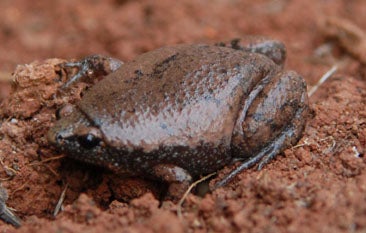SCIENTIFIC NAME:
Gastrophryne carolinensis
STATUS:
Common statewide. Lowest Conservation Concern.
DESCRIPTION:
The Eastern narrow-mouthed toad (Gastrophryne carolinensis) is a small, plump toad with short limbs, a pointed head and a fold of skin across the back of its head behind the eyes. Adults are usually 7/8” to 1¼” in length. Coloration varies from shades of gray, to reddish brown or brown. They may change color to match their environment. Males generally have dark throats and female’s throats are lighter. The bellies of both sexes are heavily mottled. The toes are not webbed. The unique skin fold on the head helps protect the eyes from ant bites and stings.
DISTRIBUTION:
The Eastern narrow-mouthed toad can be found from southern Maryland, south to the Florida Keys and west to Missouri and eastern Texas.
HABITAT:
The Eastern narrow-mouthed toad can utilize a variety of habitats, so long as they provide shelter and loose, moist soil that allows for burrowing. These toads are secretive in nature, spending most of their time in subterranean burrows, decaying logs and stumps or under rocks, bark or other vegetative debris in contact with the ground. During the breeding season, they are found along the margins of lakes, ponds, sloughs and flooded roadside ditches.
FEEDING HABITS:
Their diet is made up mostly of ants, but also includes termites, small beetles and other insects.
LIFE HISTORY AND ECOLOGY:
Breeding takes place from April through October in most of its range, but is restricted to midsummer in the north portion of the range. Breeding activity is initiated by heavy rains. Males call from shallow water, with their bodies floating and their front legs resting on vegetation. The call is like the bleat of a lamb lasting up to four seconds.
Once a receptive female is attracted, the male will climb onto her back and embrace her in what is referred to as amplexis. He then secretes a sticky substance from glands on his belly that temporarily glues him to her back. Eggs are laid in a thin floating layer on the surface of the water. Females may lay as many as 800 eggs. Eggs hatch within a few days, and tadpoles transform into adults in 20 to 70 days. Tadpoles feed on algae.
When disturbed or chased they are capable of running and often do so rather than leaping to safety. They sometimes alternate between running and hopping to escape.
REFERENCES:
Collins, Henry Hill Jr. 1981. Complete Field Guide to North American Wildlife. Harper and Row, Publishers, Inc. New York, NY 714 pp.
Conant, Roger 1975. A Field Guide to Reptiles and Amphibians of Eastern and Central North America. Houghton Mifflin Company, Boston 429 pp.
Illinois Natural History Survey. INHS Amphibian and Reptile Collection (On line). “Anura Gastrophryne carolinensis – Eastern Narrow-mouthed Toad.” https://herpetology.inhs.illinois.edu/species-lists/ilspecies/eastern-narrow-mouthed-toad/.
Mount, R. H., 1975. The Reptiles and Amphibians of Alabama. Ala. Agri. Expt. Sta., Auburn Univ., Auburn, AL. 347 pp.
AUTHOR: Mitchell Marks, Wildlife Biologist, Alabama Division of Wildlife & Freshwater Fisheries






